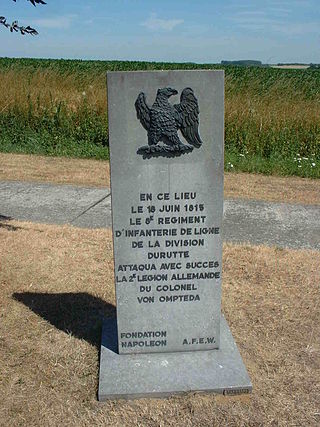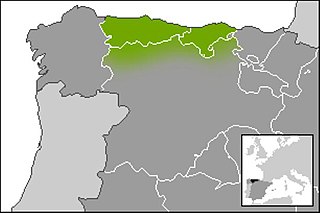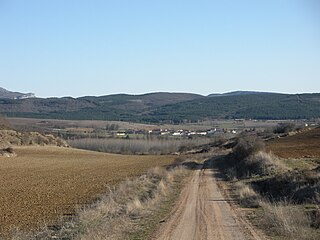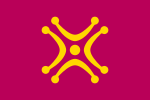
Cantabria is an autonomous community and province in northern Spain with Santander as its capital city. It is called a comunidad histórica, a historic community, in its current Statute of Autonomy. It is bordered on the east by the Basque autonomous community, on the south by Castile and León, on the west by the Principality of Asturias, and on the north by the Cantabrian Sea, which forms part of the Bay of Biscay.

The Picos de Europa are a mountain range extending for about 20 km (12 mi), forming part of the Cantabrian Mountains in northern Spain. The range is situated in the Autonomous Communities of Asturias, Cantabria and Castile and León. The highest peak is Torre de Cerredo, at an elevation of 2650 m (8,690 ft).

A stele, from Greek στήλη, stēlē, plural στήλαι stēlai, is a stone or wooden slab, generally taller than it is wide, erected in the ancient world as a monument. The surface of the stele often has text, ornamentation, or both. These may be inscribed, carved in relief, or painted.

The Astures or Asturs, also named Astyrs, were the Hispano-Celtic inhabitants of the northwest area of Hispania that now comprises almost the entire modern autonomous community of the Principality of Asturias, the modern province of León, and the northern part of the modern province of Zamora, and eastern Trás os Montes in Portugal. They were a horse-riding highland cattle-raising people who lived in circular huts of stone drywall construction. The Albiones were a major tribe from western Asturias. Isidore of Seville gave an etymology as coming from a river Astura, identified by David Magie as the Órbigo River in the plain of León, and by others as the modern Esla River.

The Cantabri or Ancient Cantabrians were a pre-Roman people and large tribal federation that lived in the northern coastal region of ancient Iberia in the second half of the first millennium BC. These peoples and their territories were incorporated into the Roman Province of Hispania Tarraconensis in 19 BC, following the Cantabrian Wars.

The Cantabrian Wars, sometimes also referred to as the Cantabrian and Asturian Wars, were the final stage of the two-century long Roman conquest of Hispania, in what today are the provinces of Cantabria, Asturias and León in northwestern Spain.

Corocotta is a local hero for Cantabrians and his story is passed down orally in Cantabrian families from the elder generations to the younger. According to Roman sources, he was a guerrilla warrior or bandit in Cantabria during the 1st century BC, who, according to Cassius Dio, raided Roman territory causing considerable depredation in the area. Dio says that Corocotta's depredations caused Augustus to offer a large reward for his capture. Corocotta himself came forward to receive it, impressing Augustus with his audacity. Dio is the only source for the story.

The Autrigones were a pre-Roman tribe that settled in the north of the Iberian Peninsula, in what today is the western Basque Country and northern Burgos and the East of Cantabria, Spain. Their territory limited with the Cantabri territory at west, the Caristii at east, the Berones at the southeast and the Turmodigi at the south. It is discussed whether the Autrigones were Celts, theory supported by the existence of toponyms of Celtic origin, such as Uxama Barca and other with -briga endings and that eventually underwent a Basquisation along with other neighboring tribes such as the Caristii and Varduli.

Torrelavega is a municipality and important industrial and commercial hub in the single province Autonomous Community of Cantabria, northern Spain.

Cantabrian mythology refers to the myths, teachings and legends of the Cantabri, a pre-Roman Celtic people of the north coastal region of Iberia (Spain). Over time, Cantabrian mythology was likely diluted by Celtic mythology and Roman mythology with some original meanings lost. Later, the ascendancy of Christendom absorbed or ended the pagan rites of Cantabrian, Celtic and Roman mythology leading to a syncretism. Some relics of Cantabrian mythology remain.

The coat of arms of Cantabria has a rectangular shield, round in base and the field is party en fess. In field azure, a tower or crenellated and masoned, port and windows azure, to its right a ship in natural colours that with its bow has broken a chain sable going from the tower to the dexter flank of the shield. At the base, sea waves argent and azure, all surmounted in chief by two male heads, severed and haloed. In field gules, a disc-shaped stele with geometric ornaments of the kind of the Cantabrian steles of Barros or Lombera. The crest is a closed royal crown, a circle of jeweled gold, made up of eight rosettes in the shape of acanthus leaves, only five visible, interpolated with pearls, and with half-arches topped with pearls raising from each leaf and converging in an orb azure, with submeridian and equator or, topped with cross or. The crown, covered in gules.

Campoo is a comarca (district) of Cantabria (Spain) located in the High Ebro. With an area of slightly more than 1,000 km2, it includes the municipalities of Hermandad de Campoo de Suso, Campoo de Enmedio, Campoo de Yuso, Valdeolea, Valdeprado del Río, Valderredible, Reinosa, Las Rozas de Valdearroyo, Santiurde de Reinosa, Pesquera, and San Miguel de Aguayo. The local inhabitants are called Campurrians . Its highest elevation is the Cuchillón peak, and the lowest is Pesquera, with the capital, Reinosa at 850 m.

Caravia is a municipality in the Autonomous Community of the Principality of Asturias, Spain. It is bordered on the north by the Bay of Biscay, part of the Cantabrian Sea, on the south by Parres, on the east by Ribadesella and on the west by Colunga.

Juliobriga was the most important urban centre in Roman Cantabria, as stated by numerous Latin authors including Pliny the Elder. The site has traditionally been identified with ruins in the village of Retortillo (Cantabria) and its Villafría district, in the municipality of Campoo de Enmedio.

The Turmodigi were a pre-Roman ancient people, later mixed with the Celts people of northern Spain who occupied the area within the Arlanzón and Arlanza river valleys in the 2nd Iron Age.

The Cantabrian caves' unique location make them an ideal place to observe the settlements of early humans thousands of years ago. The magnificent art in the caves includes figures of various animals of the time such as bison, horses, goats, deer, cattle, hands and other paintings. Archaeologists have found remains of animals such as bears, the remains of arrows and other material indicating a human presence; these artifacts are now found mostly in the Regional Museum of Prehistory and Archaeology of Cantabria.

The hexafoil is a design with six-fold dihedral symmetry composed from six vesica piscis lenses arranged radially around a central point, often shown enclosed in a circumference of another six lenses. It is also sometimes known as a "daisy wheel". A second, quite different, design is also sometimes referred to by this name; see alternate symbol.

The Battle of Vellica was a battle of the Cantabrian Wars fought in the year 25 BC by the emperor Augustus and his Roman legions against the Cantabri forces who resided in the area. The most generally accepted location for the battle is the area around Monte Cildá, Olleros de Pisuerga, Palencia.
Cantabrum is the name given by the Roman Empire to the banner used by the Cantabri to facilitate war tactics of the cavalry.




















